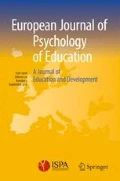Abstract
The three components of the dialogue style are: a) a great number of questions asked by the teacher during the storytelling; b) three exclusive types of questions asked; and c) a variety of questions. The present study is intended to analyse the relationships between these components and children’s story comprehension. The subjects were 48 children, aged 4;4 to 6;2, randomly divided into four groups of 12 children each: the number, exclusive types, and variety groups, and a control group (the reading group). Twenty-four teachers were also divided randomly into four groups of six teachers each, and assigned to the four children’s groups. Each teacher told the story to two children at a time; the children were chosen and paired randomly. Each child, singly, retold the story and then answered a questionaire on the structure of the story. The responses of each child were compared with the story text and considered correct if approriate to the contents of the story. The mean percentages of correct responses in the three experimental groups were higher than those of the control group. This difference is significant in the free retelling situation.
Résumé
Le but de cette étude est d’analyser les relations entre la compréhension d’un récit par des enfants et trois composantes du fonctionnement dialogique de l’enseignant (nombre, type et variété des questions posées). 48 enfants ayant de 4 ans 4 mois à 6 ans 2 mois ont été répartis de façon aléatoire en quatre groupes de 12 enfants chacun: trois groupes expérimentaux et un groupe contrôle. Les groupes expérimentaux différaient de façon systématique sur les trois paramètres cidessus relatifs au questionnement. 24 enseigmants ont été affectés de façon aléatoire au quatre groupes d’enfants (6 enseignantes par groupe), chaque enseignant racontant l’histoire à deux enfants à la fois choisis au hasard. Chaque enfant devait ensuite redire l’histoire et répondre à un questionnaire sur la structure du récit. Les performances et réponses des enfants ont été évalués par comparaison au texte source de l’histoire. Les résultats mettent en évidence l’existence de différences significatives entre les groupes expérimentaux et le groupe contrôle.
Similar content being viewed by others
References
Albanese, O., & Antoniotti, C. (1992). The influence of an educator’s interactive style on the process of comprehension in preschool-age children. In B. Wolters & W. Schnotz (Eds.),Text comprehension and learning (pp. 201–209). Amsterdam: Swets & Zeitlinger.
Barbieri, M.S., Devescovi, A., & Bonardi, P.A. (1987). L’interazione verbale tra bambino ed educatrice durante il racconto di una storia. In S. Mantovani & T. Musatti (Eds.),Adulti e bambini. Educare e Comunicare. Juvenilia.
Bransford, J.D. (1979).Human cognition, learning, understanding and remembering. Belmont: Wadsworth.
Brown, A. (1975). Reconstruction and recall of narrative sequences.Child Development, 46, 156–166.
Day, J., Stein, N.L., & Trabasso, T. (1986).A study of inferential comprehension: The use of a story schema to remember picture sequences. Unpublished manuscript.
Devescovi, A., & Burani, C. (1987). L’uso delle domande nella comprensione della lettura. In I. Poggi (Ed.),Le parole nella testa (pp. 207–225). Bologna: Il Mulino.
Emiliani, F., & Zani, B. (1983). Strategie interattive e rappresentazioni sociali in operatrici di asilo nido.Etá Evolutiva, 14, 90–95.
Levorato, M.C. (1988).Racconti, storie e narrazioni. I processi di comprensione dei testi. Bologna: Il Mulino.
Morra Pellegrino, M.L., & Scopesi, A. (1990). Structure and function of baby talk in a day-care centre.Journal of Child Language, 1, 101–114.
Ninio, A., & Bruner, J. (1978). The achievement and antecedents of labelling.Journal of Child Language, 5, 5–15.
Orsolini, M. (1985). La comprensione di storie: Che cosa sviluppa?Rassegna di Psicologia, 2, 31–59.
Schaffer, H.R., & Liddel, C. (1984). Adult-child interaction under dyadic and polyadic conditions.British Journal of Developmental Psychology, 2, 33–42.
Schank, R.C., & Abelson, R. (1977).Script, plans, goals, and understanding. Hillsdale, NJ: Erlbaum.
Snow, C.E., & Goldfield, B. (1981). Building stories: The emergence of information structures from conversation. In D. Tannen (Ed.),Analyzing discourse: Text and talk. Georgetown University Round Table on Language and Linguistics, Georgetown University Press.
Snow, C.E., & Goldfield, B. (1983). Turn the page please: Situation-specific language acquisition.Journal of Child Language, 10, 551–569.
Stein, N.L., & Glenn, C.G. (1979). An analysis of story comprehension in elementary school children. In R. Freedle (Ed.),New Directions in Discoursive Processing, Norwood, NJ: Ablex Publishing Corp.
Teale, W.H. (1984). Reading to young children: Its significance for literacy development. In H. Goelman, A. Oberg, & F. Smith (Eds.),Awakening to literacy. Exeter, NH: Heinemann Educational Books.
Tizard, B., Philips, J., & Plewis, J. (1976). Staff behaviour in preschool centres.Journal of Child Psychology and Psychiatry, 17, 21–23.
Trabasso, T., & Liu, L. (1988).Questioning and story structure. Internal Report of the University of Chicago.
Trabasso, T., Stein, N.L., & Johnson, N.S. (1981). Children’s knowledge of events: A causal analysis of story structure. In G. Bower (Ed.),Learning and Motivation (Vol. XV). New York: Academic Press.
Author information
Authors and Affiliations
Rights and permissions
About this article
Cite this article
Albanese, O., Antoniotti, C. Teacher dialogue style and children’s story comprehension. Eur J Psychol Educ 12, 249–259 (1997). https://doi.org/10.1007/BF03172874
Received:
Revised:
Issue Date:
DOI: https://doi.org/10.1007/BF03172874



